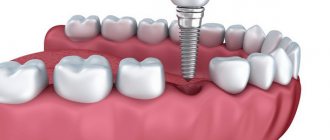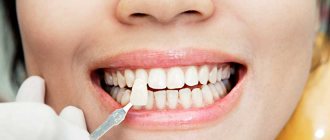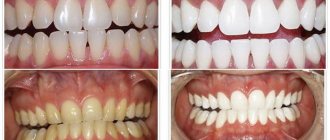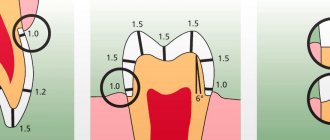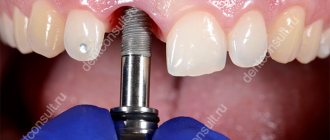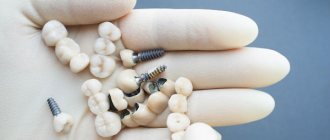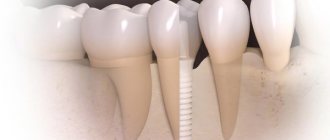Installation of dental bridges (photos are given in the article) in modern dentistry is the optimal and most common way to restore the integrity of the dentition in the absence of one or more masticatory organs. Demand for them is high and is unlikely to fall in the near future. And with proper and careful care, dentures can last for quite a long time - up to 10 years. But what are these products and what are their strengths and weaknesses? This is especially important when choosing a prosthetic method.
The feasibility of using this type of structure is determined by a specialist, and the installation itself is carried out taking into account many factors. Let’s take a closer look at this type of prosthetics and find out what advantages and disadvantages dental bridges have, and we’ll also touch on a number of other points.
What is a bridge?
This kind of design is an orthopedic product that, to be effective, requires support elements located on both sides of one missing tooth or several. Actually, dental bridges themselves consist of two parts:
- Basic crowns - they are attached to natural supporting teeth so that the entire structure is securely fixed.
- The intermediate link is already artificial teeth to replace the missing ones, their number is equal to the length of the defect.
At the same time, the supporting teeth must be strong in order to withstand the entire load that will be placed on them when chewing or biting. Such products are relevant in relation to the terminal defect, that is, in the case of a complete absence of chewing teeth. However, before installing the bridge, it is necessary to implant at least one implant, which will support it. Otherwise, the structure will be partially removable. Some dental experts do not recommend placing bridges on the front teeth, since there is a risk of root dislocation of the supporting elements.
The achievements of modern dentistry allow these structures to restore not only the aesthetics of the dentition, but also its functionality in place of the natural masticatory organs. In addition, if you put a bridge on your teeth, patients won’t even have to reconsider their diet.
If it wobbles, what should I do?
Over time, the product may become loose. But since modern developments in dentistry are used, this does not appear often. The structure becomes loose due to the destruction of supporting teeth or the cement that was used for fixation.
What to do in this case? You need to see a doctor. Typically the bridge is removed and reinstalled. If the X-ray does not show destruction of the supporting teeth, then there is no need to worry. There is no need to strengthen it, since over time the structure will wobble again.
Benefits of bridges
Fixed bridge prosthesis definitely has its strengths, otherwise how can one explain their widespread use? The obvious advantages include the following:
- The defect is eliminated quickly and painlessly.
- Installation of bridges does not involve surgical intervention.
- Not only the appearance of the dentition is restored, but also its functional state.
- Getting used to dentures does not take much time - on average it takes 2 or 3 days.
In addition, such structures, after installation, will already be part of the face, and therefore they can hardly be noticed.
At the same time, they have a clear advantage over removable dentures - there is no need to remove them every time for cleaning. For some people, this can turn into a tedious task. You can clean bridges just like you would your natural teeth.
How long will crowns and dental bridges last?
Crowns and bridges are designed to last a lifetime, but very often due to improper care, dentures become damaged and need to be replaced.
Following the rules of hygiene and careful handling of artificial teeth will help protect them from falling out. The bridge may lose support due to gum disease.
To protect yourself from damaging existing crowns, implants or dental bridges, try not to indulge in solid foods.
but on the other hand
As with any orthopedic design, all dental bridges have certain disadvantages that must be taken into account in any case. The main disadvantage is the need to grind down the abutment tooth. The bottom line is that after such treatment the unit becomes more fragile and collapses faster. In addition, the dentist is often forced to first remove the nerve and also fill the canals. In other words, in order to install just one bridge, two teeth are subject to mechanical influence.
In rare cases, an allergic reaction develops. Irritation of the mucous membrane may also occur due to the tight fit of the structure. Heavy products even lead to sagging gums over time.
Removal
If the bridge is damaged or loose or there is pain in the supporting tooth, then the structure must be removed. This work must be performed by a specialist. The person himself can damage the structure and supporting teeth. The jaw bones may also be affected.
Computed tomography can determine the extent of damage and the need to remove the bridge. Based on it, the dentist assesses the condition and performs removal. This procedure is performed in the following ways:
- A common method is scalers, which use ultrasound to decement fasteners. In this case, the crowns can be removed carefully, and then they are used a second time.
- A Koch apparatus is used to cut the prosthesis. The procedure is performed under anesthesia. This method is used if the supporting tooth hurts under the bridge. He is treated and new crowns are installed.
Types of bridges
The classification of bridges is quite extensive and includes several criteria, among which the following can be distinguished:
- Adherence to the gum - flushing, tangential, saddle-shaped (or joint to joint) structures.
- Manufacturing technology – soldered, solid-cast, adhesive bridges.
- The materials used are zirconium, ceramic, metal-ceramic, metal, metal-plastic.
Let's look at this classification in a little more detail.
Tangent bridges
Many patients prefer to place bridges on their teeth of this particular design rather than giving preference to other varieties. In this case, the prosthesis touches the gums only on one side (vestibular). In this case, the aesthetics of the dentition does not suffer, and therefore you don’t have to hide your smile. In addition, there are no problems with the accumulation of food residues after each meal.
The loss of front teeth contributes to distortion of diction, so this design is the best option for eliminating the gap. In addition, it is possible to avoid the inflammatory process of the mucous membrane in the area adjacent to the intermediate part of the prosthesis.
Price
The cost of installing a bridge is determined by many factors. The cost mainly depends on the material from which the prosthesis is made.
Metal-ceramic bridges are the most expensive. The price of the product is no less than 9 thousand rubles per tooth. The average cost of finished bridge prostheses is 14–37 thousand rubles.
Thus, dental bridges allow you to maintain normal chewing function and a beautiful smile. The main thing is that the installation is carried out by a specialist. And the patient just has to follow all the recommendations for caring for the structure, and then it will last for a very long time.
Saddle bridge structures
They are used in rare cases, and mainly in relation to the frontal dentition. The product fits tightly to soft tissues, but the appearance may suffer, which imposes a certain psychological discomfort. However, in some cases this is the optimal solution when there is no choice.
The rarity of the use of bridges of this type is due to the accumulation of tiny food particles, which leads to the active development of pathogens. As a result, bad breath appears, and gum inflammation - gingivitis - begins.
Those patients who have received such a design should be more careful about oral hygiene.
Recommendations for caring for dental bridges
In addition to the general rules of daily hygiene (cleaning with paste and brush at least twice a day - morning and evening, as well as every time after eating), additional requirements must be observed. So how do you clean dental bridges? In addition to the usual brushing with a soft toothbrush (each tooth separately, sweeping movements from the gum to the cutting edge), you must also use an irrigator, and if you don’t have one at hand, thoroughly rinse your mouth with water. The presence of a flushing hole between the central part of the dental bridge and the gum greatly facilitates the daily care of the denture. In addition, during professional oral hygiene, which, by the way, must be carried out at least twice a year, the hygienist should pay special attention to the bridge prosthesis - check for food debris and plaque accumulation at the junction of the prosthesis and gums, and also carefully polish artificial teeth and crowns on supporting teeth.
Soldered bridges
Like the saddle models mentioned above, they are not widely used in dental clinics. The entire structure is represented by stamped crowns (for supporting teeth), which are soldered to solid-cast spaces.
Their main drawback is the presence of a metallic taste in the mouth, which will not please anyone. In addition, the quality leaves much to be desired. It is important to take into account that in the manufacture of these prostheses, dissimilar metals are usually used, which can inevitably lead to the occurrence of galvanic current. In turn, this phenomenon is accompanied by various dental diseases.
But the disadvantages do not end there - the structure does not fit tightly to the supporting teeth. As a result, food debris and plaque accumulate. The development of caries is a matter of time, and it is very difficult to detect under the crown.
Installation of metal-ceramic dental bridges
Stage 1 - consultation.
During the first visit to the doctor, anamnesis is collected and the rehabilitation method is agreed upon.
Stage 2 - rehabilitation.
Preparation of the oral cavity, treatment of concomitant dental diseases, if any.
Stage 3 - production of the prosthesis.
Computer modeling is considered the most advanced and most accurate method for manufacturing orthopedic structures. In the case of metal ceramics, a metal frame is first made, and after applying the ceramics, the product is fired.
Stage 4 - implantation.
If the product is fixed on implants, a surgical stage is necessary. A classic denture requires grinding of adjacent teeth.
Stage 5 - installation.
Fitting and installation of the finished structure.
Solid products
Products are manufactured in a laboratory based on impressions made by a doctor. In order to obtain strong and reliable bridges, a combination of chromium with cobalt or nickel is used. The result is an alloy that has enviable strength, reliability and, therefore, can last a long time. The risk of breaking such a prosthesis, even in case of heavy load, is minimal.
During the manufacture of a solid-cast dental bridge, the photo of which you can see above, any error is eliminated - the utmost precision is maintained. In addition, an alloy of cobalt and chromium is predominantly used, due to which there is no heterogeneity, as in the manufacture of soldered structures with stamped crowns.
However, such products also have their drawbacks. Firstly, the metal is visible in the oral cavity, which somewhat distorts the aesthetic side of the issue, although the anatomical shape of the teeth has been completely recreated. But if desired, the frame can be hidden under ceramics or plastic.
Secondly, dental bridges are quite heavy. Largely for these reasons, such orthopedic products act as budget prosthetics for replacing lateral teeth.
The process of creating and installing a structure
- preparatory stage: first, the patient undergoes a complete sanitation of the oral cavity, which includes treatment of caries and removal of dental plaque. In some cases, it may be necessary to remove the pulp from the supporting elements and fill the canals.
- processing of supporting elements: a specialist grinds the teeth, giving them a slightly cone-shaped shape for strong fixation of the prosthesis. If the crowns of the supporting elements are damaged, it may be necessary to strengthen the roots using stump inlays,
- taking impressions: the doctor takes impressions from both jaws to create the most comfortable design,
- making a denture: answering the question of how dentures are made, it should be noted that this is done by professional technicians in a separate dental laboratory,
- The bridge is placed in the oral cavity and attached to the supporting teeth using special dental glue.
Adhesive structures
What are the best bridges for teeth? Adhesive structures are a real breakthrough in dentistry! The main advantage of these orthopedic products is that there is no need to prepare healthy abutment teeth. True, they will still have to be processed, but on a much smaller scale. In addition, it is not even necessary to remove the dental nerve, thereby leaving the unit alive. In this case, production is possible in the oral cavity itself and during one visit.
Fiberglass tape is glued to healthy abutment teeth and artificial composite analogues are attached to it using photopolymer materials. However, adhesive products have a noticeable drawback - the polymer changes color over time. In addition, the prosthesis itself is not as durable as soldered or solid structures.
How can a dental bridge be attached?
In most cases, a dental bridge is a fixed prosthesis.
In most cases, a dental bridge is a fixed prosthesis. However, if there are medical contraindications to the installation of a fixed prosthesis, or the patient himself refuses to install fixed structures, removable dentures with locks can be used.
There is also a way to attach a “bridge” to healthy teeth without preparing them. In this case, the structure is fixed using a special adhesive material. True, such structures are not very reliable, and their service life rarely exceeds 1-2 years .
Zirconium dioxide
This is almost an ideal option for bridges on the lower teeth. Such prostheses are manufactured using innovative CAD/CAM technology. Initially, the model is designed on a computer in three-dimensional form. Subsequently, on its basis, the prosthesis itself is turned from a solid block using a milling machine.
There are two types of such structures. In the first case, the frame is cast, then medical porcelain is applied on top. The result is products that are as similar as possible to natural teeth. They even have the translucency of natural enamel. But such material is prone to chipping.
Another option is to make it from a monolithic block. The result is a more durable prosthesis. But here too there are some nuances. Firstly, the products have an unnaturally white tint. Secondly, the transparency inherent in natural teeth is completely absent.
However, this does not prevent you from highlighting certain advantages when you need to decide which bridges are best to install on your teeth:
- The strength of prostheses is not inferior to metal structures.
- The only and optimal solution, if necessary, to cover the absence of three or more teeth in a row.
In addition, these orthopedic products are relevant not only for lateral defects; they can be supplied to replace missing anterior units.
What are crowns
These products are non-removable structures. When worn, the patient does not need to constantly remove and put on crowns. They can fully replace a lost tooth and restore all its functions.
Important! Installation of a crown is required in order to eliminate an anatomical crown defect that is destroyed. These artificial elements provide effective protection of natural teeth from destruction.
Crowns provide the following functions:
- provide a change in the shape of teeth. Typically, crowns are intended for teeth that have an incorrect position in the dentition or have an irregular anatomical shape;
- change the external structure of the tooth;
- to cover the tooth, which will further provide its protection.
Crowns are made from different types of materials. The choice of these products depends on the patient's capabilities, as well as the extent of the lesion. Products made of ceramics and porcelain are as close as possible to the structure of natural teeth. Products are also made from metal alloys and gold. Metal crowns are considered the most budget-friendly options.
An artificial crown is a tooth prosthesis that restores its anatomical shape, providing aesthetics and maintaining chewing function. The main purpose of a crown is to strengthen a damaged tooth, preventing its further destruction.
Ceramics
In this case we are talking about the E-Max system. And among a large number of fixed-type prostheses, these products are distinguished by high aesthetic indicators. The color of artificial substitutes is selected based on the anatomical characteristics of the patient. And due to the high degree of transparency, these teeth are practically indistinguishable from natural enamel.
At the same time, certain disadvantages must be taken into account:
- The material itself is quite fragile, and therefore suitable for replacing canines and incisors. Only in rare cases can they be placed instead of premolars. Due to its fragility, it is not suitable for molars, since these teeth bear a large load that ceramics cannot cope with.
- Only one tooth can be replaced; if several units located nearby are lost, this option is not suitable.
- High cost - the material is very expensive.
The only advantage of dental prosthetics with bridges of this type can be considered an insignificant degree of processing of the supporting teeth.
What are the average prices in Moscow clinics?
- Prosthetics with a metal-ceramic crown with a NiCr ledge from RUB 12,000.
- Prosthetics with a metal-ceramic crown using shoulder masses from 17,000 rubles.
- Prosthetics of a temporary crown using the laboratory method from RUB 3,000.
- Prosthetics with a metal-ceramic crown for 1 tooth in a fixed prosthesis on CoCr alloy, Heranium P from RUB 15,000.
- Prosthetics with a solid crown from RUB 8,000.
- Prosthetics of a temporary crown using the direct method from RUB 3,000.
Metal ceramics
This is already a more preferable material for replacing even molars. Essentially, it is a metal frame on top of which a porcelain mass is laid. Only due to the lack of transparency, neither canines nor incisors should be replaced with such prostheses. In addition, it is worth considering one nuance - over time, constant contact of the lower part of the prosthesis with the mucous membrane leads to a gradual lowering of the gums (recession) and exposure of the metal. In addition, the soft tissues themselves take on a bluish tint.
In addition to standard designs, other options are also produced. Among them are dentures of increased aesthetics - more expensive ceramic mass is used for cladding. Another type is bridges with shoulder mass - their lower part is also lined with ceramic, which helps prevent receding gums and the appearance of cyanosis.
Metal
Metal bridges were common for a time. However, today they are used less and less, which has brought these products into the category of budget orthopedic structures. This is understandable - metal products have many disadvantages. And among them the following can be distinguished:
- Aesthetics leave much to be desired - a metal bridge with a missing tooth looks bad against the background of natural enamel.
- Due to poor marginal fit, soft tissues are injured and the hygienic procedure is also difficult.
- Almost constant companions of metal bridges are galvanic currents, leading to galvanosis and other serious complications.
- The crown of the tooth is gradually destroyed.
Of course, there are also advantages - affordable price and good strength. In addition, when installing such dentures, the grinding of the supporting teeth is carried out to an insignificant extent. The previously mentioned soldered and solid-cast structures specifically refer to metal bridges.
Peeling off the bridge
Improper fixation of the bridge or ingress of saliva during its installation can cause it to come off immediately after the installation procedure. In this case, you should immediately consult a doctor so that he can correct the situation and re-glue the prosthesis. This way you will avoid reworking the bridge due to displacement of the supporting teeth.
If the bridge comes unstuck long after it was installed, an immediate trip to a specialist is also indicated. Food that gets under the bridge can develop bacteria and lead to infection, as well as damage to supporting teeth. A loose bridge can lead to the same consequences.
A specialist, if contacted in a timely manner, can slightly alter the structure and reinstall it on the supporting teeth.
When choosing a doctor to install a bridge, you need to choose a professional who will do everything efficiently, and you will not have to contact him again to restore the structure. With each new visit and reinstallation of the bridge, the supporting teeth are ground down again, which leads to their gradual thinning and destruction.
Metal-plastic
These bridges can be considered one of the types of metal fixed prostheses. The frame here is made of metal, and a layer of plastic is placed on top of it. The result is products with higher aesthetics than their all-metal counterparts.
At the same time, metal-plastic bridges (after tooth extraction they are installed quite often due to their affordable cost) have the same disadvantages as solid-cast bridges. You should also not discount a number of nuances:
- plastic is prone to chipping;
- the upper part of the dentures is exposed to pigments, resulting in coloring and darkening;
- the entire structure looks bulky and often stands out against the background of the rest of the teeth.
All these and many other nuances should be taken into account before giving preference to one or another orthopedic product. As you can see, each has its own pros and cons. Therefore, you should look for a middle ground in each specific case.
Metal-free ceramics
The material has high aesthetic values; such teeth cannot be distinguished from real ones. When making crowns, the following materials are used:
- Pressed ceramics (porcelain). Such crowns provide the highest aesthetic results, but they are also the most fragile. Ceramic crowns last an average of 5 years. The cost of such a product is about 10,000 rubles.
- Aluminium oxide. The color of this material is lighter than that of zirconia, which is why aluminum oxide is considered preferable in aesthetic dentistry, but it is also less durable. Suitable for restoring front teeth; not recommended for chewing teeth. The material is bioallergenic, does not darken, and lasts 10–15 years. The cost of one crown is from 15,000 rubles.
- Zirconium dioxide. Crowns have a longer service life - 15-20 years. Their main advantage is absolute biocompatibility. In addition, they do not cause allergic reactions. But such prostheses are more expensive - 15,000–30,000 rubles per crown.
We suggest you familiarize yourself with How you can correct your bite without braces.
To summarize, we note that in the case of porcelain structures, the excellent appearance comes at the expense of wear resistance and reliability. Such crowns are fragile and cannot withstand significant chewing load. Typically, crowns made of pressed ceramics are used for prosthetics of the upper incisors. But their “colleagues” - zirconium dioxide crowns - on the contrary, are wear-resistant and aesthetically pleasing.
Bridge or implant?
Many patients in dental clinics are interested in the following question: which is better - a dental bridge or an implant? It all depends on the situation. If one or two teeth are missing, it is more advisable to give preference to implants.
At the same time, dentists must first correctly assess the likelihood of such an installation, taking into account the general health of their patients. The benefits of installing an implant are obvious - the element is implanted into the bone structure itself, due to which a natural load is subsequently created during chewing food. In turn, this allows you to avoid atrophy of the jaw bone tissue, since it sags in the area of missing units.
Perhaps the only drawback of implantation is the high cost of the procedure. Therefore, if it is necessary to eliminate a longer defect (3 or more units in a row), installing a bridge will be beneficial from an economic point of view.
Installation of bridges
The procedure for replacing the back and front upper teeth with a bridge (or lower ones) can be divided into several stages:
- First, the patient's oral cavity is examined. If there are traces of caries and other dental diseases, therapeutic and preventive measures are necessary, including the removal of plaque and tartar.
- If necessary, the dental nerve is removed, but for the most part the unit itself is left alive.
- The following is the procedure for preparing dental tissues using a drill. As a rule, a layer of enamel and dentin is removed: from the top - 1.5-2.5 mm, from the side - 1-1.5 mm. It all depends on the type of prosthesis being installed.
- Impressions are taken.
- Based on the impressions, a plaster model of the jaw is made in the laboratory.
- Now the design itself is being made, and depending on the complexity, this can take from 1 week to a month.
- At the final stage, the finished prosthesis is attached to the supporting teeth using cement.
As you can see, the prosthetic procedure can be completed in two visits by the patient to the dental clinic. The first time the oral cavity is prepared and impressions are taken, and the second time the bridge is fixed.
Since making a prosthesis takes quite a bit of time, during the period while it is being made, the dentist places temporary plastic linings to protect the treated teeth.
What to do if the installed dental bridge begins to wobble?
If you suddenly feel that the dental bridge installed for you has begun to wobble, contact the dentist immediately! There are several reasons why this phenomenon may occur:
1. One or two supporting teeth are broken.
2. The composition used for the final fixation of the dental bridge in the oral cavity has deteriorated.
You cannot determine the reason why the dental bridge suddenly began to wobble on your own; you need professional diagnostics. When you come to the clinic, the doctor will conduct an examination and also prescribe an X-ray that will allow you to assess the condition of the supporting teeth and their roots and find out exactly why the dental bridge no longer holds firmly in the oral cavity.
In any case, to secure the dental bridge, it will have to be removed. There are no other ways to secure the structure in the oral cavity, and we strongly recommend that you do not follow advice from the Internet on securing dentures with glue and other compounds. This can lead to the most negative consequences - the development of a severe allergic reaction, inflammation and burns of the soft tissues of the oral cavity.
How much does it cost to put a bridge on teeth?
How much will it cost to install a bridge? It all depends on many factors. The final price is formed from the cost of the design itself and the work of a specialist. You should also take into account the availability of necessary procedures at the stage of preparing the dental cavity for prosthetics.
The cheapest option is plastic prostheses, while expensive products are made from zirconium dioxide. In addition, it is worth considering the pricing policy of the dental clinics themselves. On average, you can pay from 3 to 5 thousand rubles for the cheapest solution. The cost of more expensive prostheses starts at 20 thousand.
Comparison of the main types of dental crowns: pros and cons
This table presents the results of a comparison of different types of crowns.
| Crown type | Advantages | Flaws |
| Metal | Durability, strength, affordable price | Unsightly appearance, may cause galvanic reactions |
| Metal ceramics, precious metal | Natural look, hypoallergenic, durable | Quite a high cost |
| Ceramic metal, not precious metal | Acceptable external characteristics, strength, affordable price | May cause allergic and galvanic reactions |
| Pressed ceramics (porcelain) | High aesthetics, biocompatibility | Fragility, fragility |
| Zirconium dioxide | High aesthetic indicators, biocompatibility, do not cause allergic reactions, durability | High price |
| Aluminium oxide | The highest aesthetic indicators, biocompatibility, do not cause allergic reactions | Less durable than zirconia crowns |
| Metal-plastic | Low cost | Not durable, may cause irritation and allergic reactions |
Bridge on implants
Not only the teeth themselves (after appropriate treatment), but also implants can serve as support for bridges. Both cases have their pros and cons. Let's look at some significant differences that exist between these two options. To complete the picture, and also to avoid puns, we will call bridges with implants innovative.
So, it’s time to move on to describing the differences between bridges with implants and teeth (natural):
- Unlike the classic design, a design supported by implants can last a long time - from 15 to 20 years. Prosthetics with natural teeth will last at most 5 years.
- The traditional method does not allow replacing the entire dentition, that is, in the absence of all units. With a bridge on implants this is not a problem.
- With innovative dentures, when chewing, the load on the jaw is distributed evenly, as is the case with all healthy teeth.
- The traditional method of prosthetics does not have such a long healing period, which is inherent in the innovative one. In the latter case, this may take from 3 to 6 months.
- When installing bridges with implants, healthy teeth are not affected.
And finally, the most important difference between bridges with implants and teeth lies in their cost.
The use of implants implies certain advantages that may cover the advantages of traditional bridges. But the price for this is very high. Therefore, sometimes the only correct solution is to give preference to bridges supported by healthy teeth.
Installation Features
It is important not only to determine for yourself which dental bridges are best, but also to choose a qualified, experienced doctor. Due to inaccuracies in calculations and poor-quality installation, complications most often arise. Therefore, it is best to have prosthetics done in a trusted clinic. Preparation for dental restoration occurs as follows:
- An examination is carried out and an x-ray is taken.
- The doctor prepares the mouth for prosthetics, treats the teeth (filling them if necessary), removes nerves, and grinds the supporting units.
- Impressions are taken.
- The design is being manufactured and tried on, and corrections are made if necessary.
Modern technologies allow measurements to be taken as accurately as possible. To achieve this, technicians no longer need to use outdated methods. Only when the doctor is satisfied that the product is suitable will he fix it with a dental cementing solution.
The patient will be given detailed instructions on the care and hygiene of the product, as well as recommendations for eating. After the recovery period is over, the person can eat regular food and take medications, including propionate, but caution should be exercised when consuming solid foods.

